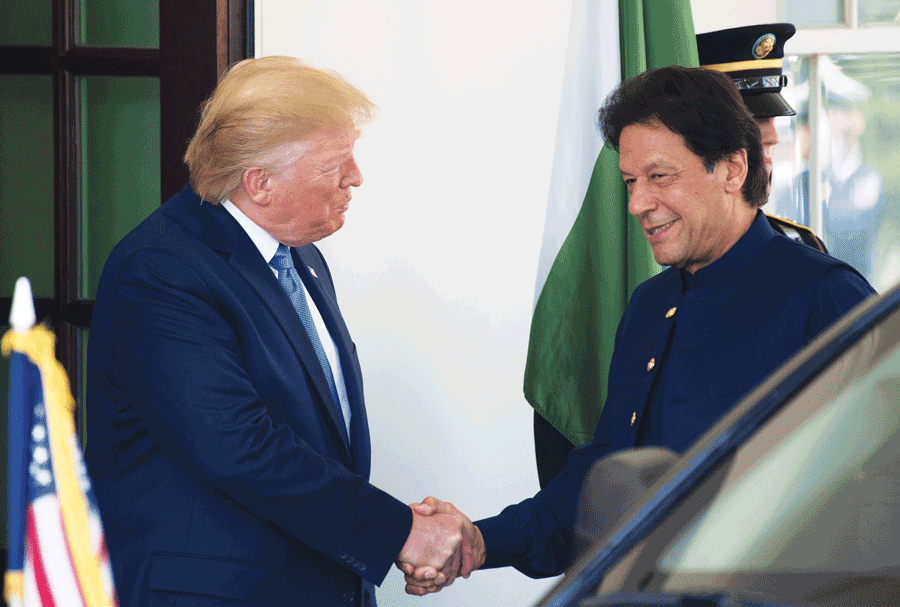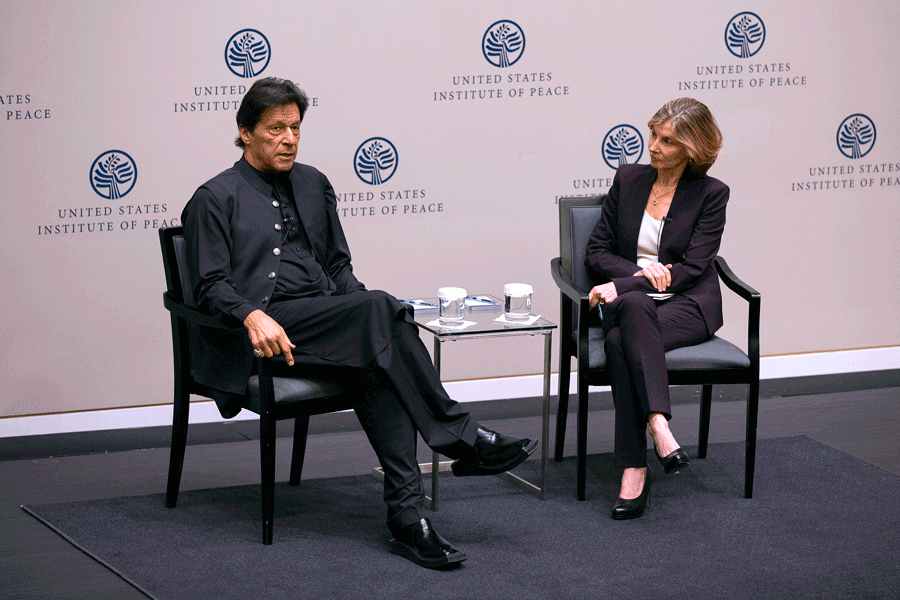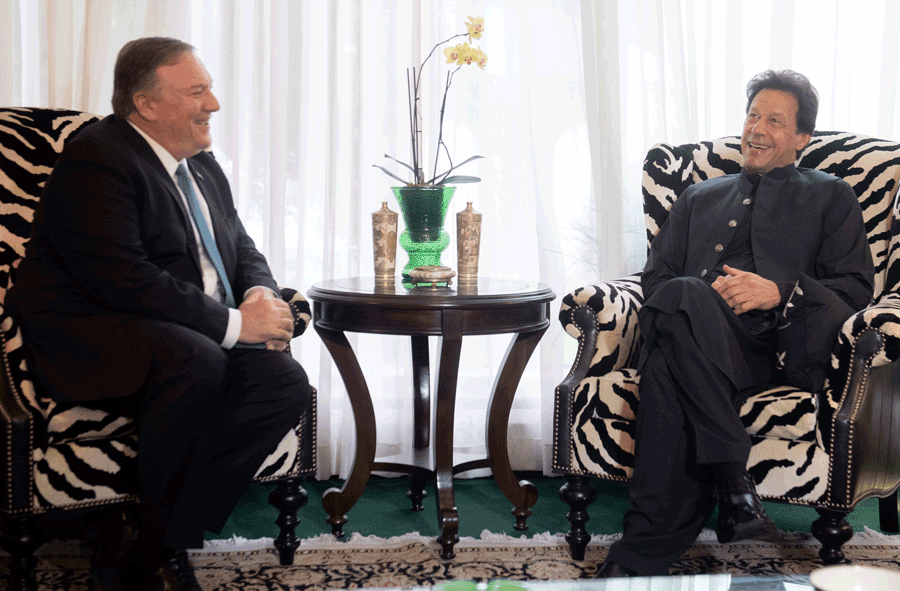The Charm Offensive
By Ejaz Haider | Cover Story | Published 6 years ago
For most Pakistan Tehreek-e-Insaf (PTI) partisans, Prime Minister Imran Khan’s initial visit to the United States was his veni vedi vici moment. While personalities do play a role, negative or positive, interstate relations are more a function of context. This is specially and historically true of US-Pakistan relations over the past seven decades, with its highs and lows.
Put another way, the two countries have been there and done it, today’s fresh breath becoming tomorrow’s halitosis. The point, therefore, is to sidestep the partisan puddles in trying to analyse what happened in Washington D.C. In fact, more than that, to see why Mr Khan was there in the first place. Consider.

Firstly, the visit took place outside the system, i.e., the Daedalian bureaucratic maze which defines the workings of the Beltway, with its multiple shops. It is interesting that on July 10 at a State Department briefing, the department spokesperson, in response to a question with reference to Khan’s visit, could not confirm it, saying the State Department had no official confirmation of the visit from the White House. The question had been asked in view of reports from Pakistan, citing the Pakistani government’s confirmation that Khan would be visiting the United States on July 22. Later, the same day, the White House confirmed the visit, clarifying the confusion created by the State Department’s earlier refusal to confirm the visit.
It should be obvious that the invitation came not just from the White House, but directly from President Donald Trump and his inner coterie. Some reports have also suggested that Trump’s son-in-law, very close to Saudi Arabia’s crown prince, Mohammad bin Salman, was convinced by the latter to get Trump to invite Khan.
Be that as it may, the sherpas in the US system did not know much about it. They weren’t involved and weren’t asked to prep for it, prepare briefs, talking points et cetera. This was perfectly in keeping with Trump’s now-known style of conducting the business of state where even the Secretary of State often gets to know of Trump’s approach through his morning tweets.
So, why would Trump decide to invite Khan? That forms our second point. Trump has raged against unwanted, Pareto-inefficient wars since he hit the campaign trail. Much to the chagrin of the traditional, inside-the-Beltway policy elite, he is (a) not much given to the ideals of neoliberal hegemony and (b) likes to transact from one issue to another. In other words, he doesn’t have a big liberal story, to use Harari’s term, to guide his hand.
We know how he steered the course on Afghanistan. His national security team was asked to review the policy. They did and presented it to him. He was not convinced and sent them back to the drawing board. This happened three times. Even when he did outline the review on August 21, 2017, he made clear that “My original instinct was to pull out — and, historically, I like following my instincts.” Yet, he allowed his national security advisor and secretary of defence to prevail upon him then because, as he said, “But all my life I’ve heard that decisions are much different when you sit behind the desk in the Oval Office.”

Imran Khan and United States Institute of Peace President, Nancy Lindborg, take part in a discussion at the United States Institute of Peace (USIP) in Washington DC, on July 23, 2019.
At the time he also said that “For its part, Pakistan often gives safe haven to agents of chaos, violence and terror.” This was in keeping with how inside-the-Beltway traditional policy elite perceives and presents Pakistan. Washington D.C. is not a place where Pakistan could win a popularity contest. Again, it’s interesting to note that historically US-Pakistan relations have been more a function of how the White House has interacted with Pakistan than how and/or if Pakistan has been able to work the Hill.
By September 2018, a little more than a year after Trump’s Fort Myer speech on Afghanistan, Ambassador Zalmay Khalilzad was tapped as the special envoy for peace and reconciliation in Afghanistan. Since his appointment, a clear indication that Trump is dissatisfied by what his national security team and his generals had fed him, the US has held eight rounds of talks with the Taliban in Doha, Qatar’s capital.
This is what constituted the centrepiece of Trump’s invite to Khan, Khan’s direct meeting with Trump and also at the delegation-level talks. In other words, if Trump hadn’t become frustrated with the non-results of his Afghanistan policy review, if, consequently, he hadn’t decided to open a channel with the Taliban, if, having done that and now preparing for his next campaign he weren’t in a hurry to stitch a deal in Afghanistan, Khan wouldn’t have been in the White House.
Point three then takes us back to the context. One, this is, and remains, the context. The rest are optics. Two, the US bureaucracy was kept away and while it will do everything to claw back in, for now Trump has trumped it. This is what Foreign Minister Shah Mehmood Qureshi meant when he said, “We cannot forget the fact that the relationship between the two countries was such that no door was being opened for us in the time of Alice Wells and Lisa Curtis,” a reference to how the Blob kept Pakistan in the doghouse. Three, this visit is just a foot in the door; the door is far from fully open.
This is not to say that nothing else was discussed or, now that sherpas are involved, nothing else is being discussed. Pakistan does want a quid for the quo. That’s standard. There’s the US pursuit of FATF against Pakistan; Trump’s earlier decision to freeze monies from the Coalition Support Fund; the US Congress’ denial to Pakistan of Foreign Military Financing; Pakistan’s desire to have more access to the US market for its exports et cetera. Given the condition of Pakistan’s coffers, help in these areas is crucial. There’s also the sense, correctly, that convergence and engagement on a multiplicity of interests would help make relations more strategic than transactional.
But, and this is imperative for Pakistan to understand, in the end, the context is Afghanistan – get the Taliban to agree to a deal and take the talks to the next level; get them to declare a ceasefire; get them to start talking to the government in Kabul, as also other stakeholders in Afghanistan; and ultimately, lay down arms and become a political entity etc. Also, that this context, in its immediacy, is being driven by Trump’s pressing desire to bring the war to an end before he hits the campaign trail for a second bid for the Oval Office.
Corollary 1: the broader reset of relations is precisely where the sherpas can make things difficult for Pakistan.
Corollary 2: if one still needs to spell it out for the partisan: given the context, anyone in the Prime Minister’s Office at this juncture would have been invited to the White House. It just so happens that the current occupant is Khan.
Now, to the challenges.
Both at the White House and, later, speaking at the United States Institute of Peace, Khan said that he would do whatever he could to get the Taliban to make a deal with the US. At the USIP, during the Q&A session, Khan revealed that the Taliban wanted to meet with him but he declined because of objections from President Ashraf Ghani’s government. He said, however, that after having met with Presidents Trump and Ghani, he was prepared to meet the Taliban delegation and use his influence to make them amenable to a deal. [NB: his exact words are available from transcripts of what he said on both occasions.]
This is a big commitment, with Khan having put his personal weight behind the effort, making the success and/or failure of it about his personal diplomacy. It’s important to note that Trump is not looking for a failure here. He has invested much in his rather unpopular policy of reaching out to the Taliban to want to return from it with nothing to show for it. The US national security establishment, for the most part, is opposed to a policy which, they think, began by giving the Taliban an upper hand in the negotiations. The Ghani government is deeply unhappy with the policy and Ambassador Khalilzad for cutting it out of the process and accepting the Taliban opening position that the movement won’t talk with Kabul’s ‘puppet’ government.

Khan and US Secretary of State, Mike Pompeo, at the Residence of the Pakistani Ambassador in Washington, DC.
Even so, Trump has gone along. The sticking point, despite multiple rounds, remains: the US wants the Taliban to (a) declare a ceasefire and (b) accept talking to the Kabul government; the Taliban want the US to first announce a withdrawal timeline before they agree to take the talks to the next level.
The biggest challenge for Khan would be to break this logjam. The two sides want the sequencing to be in their favour. Can Khan create a simultaneity? Since his statements in the US, the Taliban have said that they would be amenable to travelling to Pakistan if and when they get a formal invite for a visit. “We visit regional and neighbouring countries from time to time, so if Pakistan formally invites us we will go because Pakistan too is our neighbour and a Muslim country,” Sohail Shaheen, the Taliban spokesperson in Doha, told the BBC. Reports suggest that the visit should be expected by mid-August and would take place with the consent of Ghani’s government.
Shaheen also said that “We [Taliban] have divided the Afghan [negotiations] issue into two stages, one external and the other internal. The negotiations underway in the first stage have reached the concluding stage. If these talks turn out to be successful, then in the second stage we will hold talks with all Afghan parties, in which the Afghan government too can participate as a party.”
Pakistan has always maintained that its role is to facilitate a process that is ultimately Afghan-led, -owned and -driven. In other words, how the process works and where it leads to is the stage Pakistan doesn’t really want to be involved in. In any case, that stage has not come yet, despite the Taliban meeting Afghan delegations informally at the Moscow conference and then, last month (July), in Doha.
What is important at this stage is to convince the Taliban to accept a ceasefire and agree to talking to other Afghans, including the current government in Kabul. This, in itself, can be tricky because of the presidential elections campaign which the Taliban are not interested in at this stage, given that they have no political presence on the Afghan stage.
The July 28 attack on the campaign/party office of Amrullah Saleh, Ghani’s running mate for the post of vice president, is generally considered to be an attempt to disrupt the elections.
The Kabul government, especially Ghani, is strongly wary of and opposed to any suggestion that talks could, or should, lead to an interim government to oversee the process of transition. The opposition makes eminent sense from the perspective of the current power configuration in Kabul. Equally, Taliban insistence that the details be worked out before they agree to an intra-Afghan dialogue or a ceasefire makes sense from the movement’s point of view: it would be naive to think that the Taliban leadership would at this stage throw away their gains on the battlefield at the table without something solid to sell to their fighting cadres.
The rock Khan has agreed to roll up the hill is therefore not an easy venture. He will give it his best shot; that’s for sure. But he would need to aggregate multiple contradictory interests in trying to do that. There are devices like proximity talks that could be relied upon in the opening stages of any intra-Afghan talks but the devil, as always, lies in the detail.
Finally, the rest of US-Pakistan relations, as also the reset, will depend on what happens to Trump’s Afghanistan policy. It was great to see Khan doing the photo-op at the White House and Lindsey Graham praising him effusively, as he did when he met Khan in Islamabad, but the real test is about to begin. Trump is not counting on failure and the Blob won’t let go of any opportunity to put Pakistan back in the doghouse.
Ejaz Haider is an executive editor at Indus News and also anchors his show. His twitter handle is @ejazhaider.


